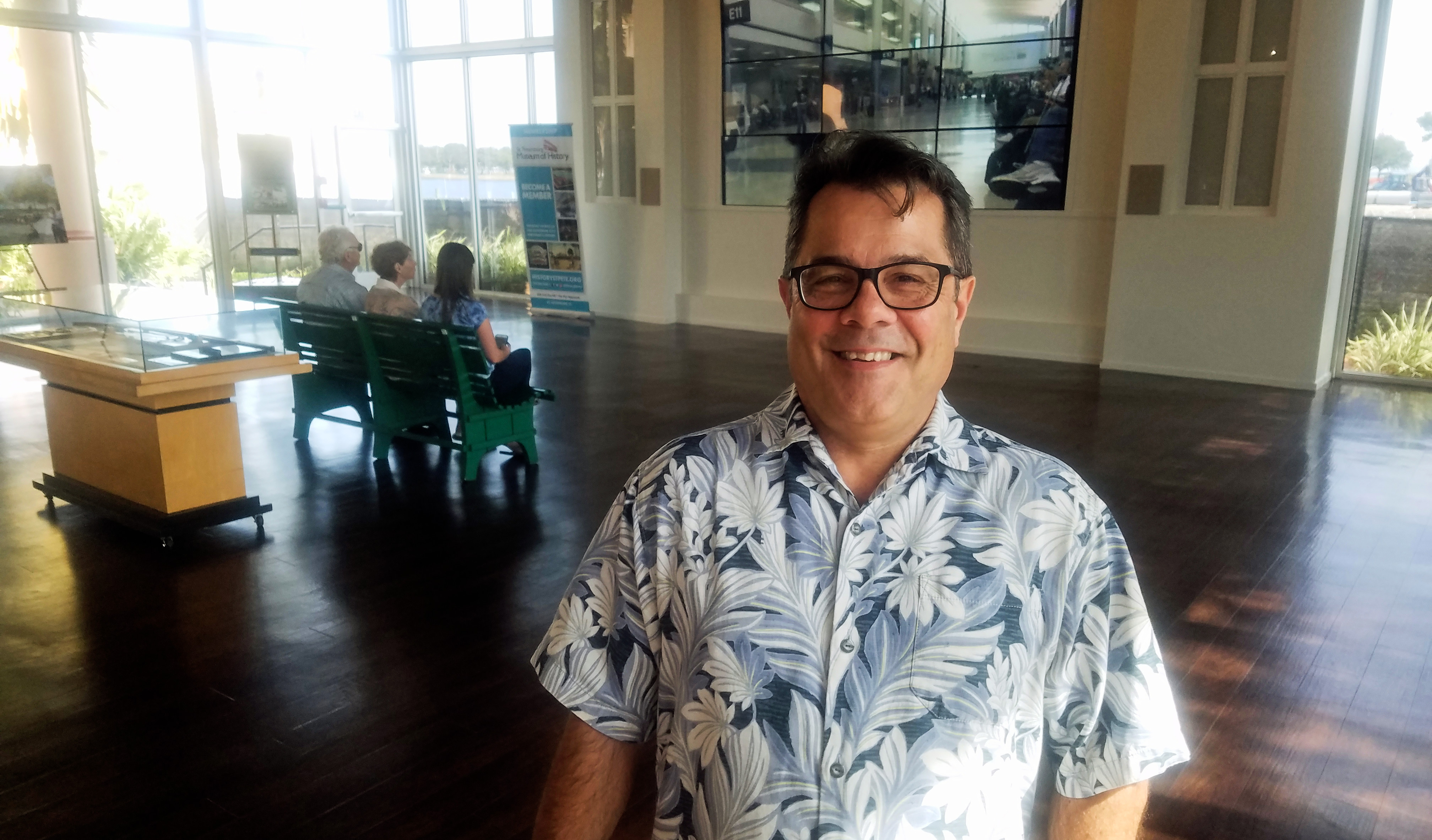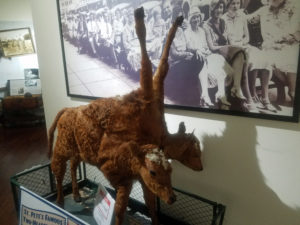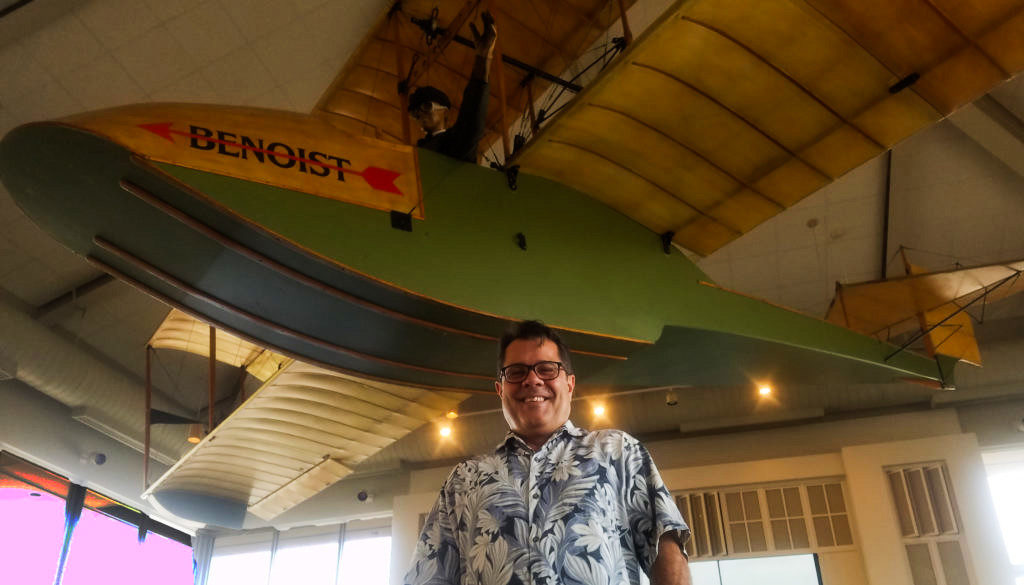Forward into the past: The St. Petersburg Museum of History looks ahead

The earth-turning and concrete-pouring for the new St. Pete Pier is taking place right outside Rui Farias’s office window. Every day, the executive director of the St. Petersburg Museum of History looks out on heavy machinery, mounds of dirt and an unsightly orange fence that warns visitors away from the construction zone.
“We knew it was going to affect us,” Farias says, “and I told City Council this: For all practical purposes, it looks like we’re shut down.” The museum is, in fact, open for business, although attendance is off because visitors have to seek out the entrance, behind the orange fence.
The pier is still a year away from completion. “But this gave us a little kick in the butt, which we needed,” explain Farias. “we’ve been planning an expansion, and when this thing happened it sent everything into hyperdrive.”
 Although the building has been shored up, torn down, gutted, re-constructed, renovated and expanded upon, the St. Petersburg Museum of History has been in the same spot, at Bayshore and 2nd Avenue N., since 1922. It was there before the famous Million Dollar Pier went up, with its own machinery and piles of dirt, in ‘26.
Although the building has been shored up, torn down, gutted, re-constructed, renovated and expanded upon, the St. Petersburg Museum of History has been in the same spot, at Bayshore and 2nd Avenue N., since 1922. It was there before the famous Million Dollar Pier went up, with its own machinery and piles of dirt, in ‘26.
The main parking lot for the city’s new $76 million pier, and the passenger trolley pickup and dropoff area, will abut the front of the history museum.
For Rui Farias, the St. Pete High history teacher who’s been running the 96-year-old nonprofit since 2014, that’s the sound of opportunity knocking.
The museum’s long-gestating expansion, adding an additional 8,000 square feet, is out of the planning stages and on the road to reality. Although one-third of the necessary funding has been raised, through private donations, and from the City of St. Pete (which has pledged $1 million), a capital campaign will begin in January. Local legislators have promised to seek state funds for the project.
The design includes a welcome center for the entire pier district, and an addition to the second floors that includes a main gallery and additional room for the archives and research areas.
“The changes to the building will not just be the addition – we’re going to rip out the lobby and what is the current main gallery, we’re going to re-do all the floors, re-do a lot of cosmetic stuff to the existing building,” Farias says.
He believes the time is right for the St. Petersburg Museum of History to take its place in the city’s cultural pantheon. “We’ve become such a cultural arts destination as a city, and we’ve got some amazing history in this town,” Farias enthuses. “But nobody really takes us or Florida seriously when it comes to history. The basic struggle has been to show that history is cool.”
It wasn’t even remotely cool when Rui Farias was growing up near downtown. Although the self-professed “history geek” took regular Saturday-morning bike rides to the museum (and to nearby Northshore Pool), he rarely if ever had to elbow anybody out of his way.
“Back then,” he says, “the museum looked like your grandmother’s attic. It was just stuff everywhere, and in cases, piled up. Which to me was really cool.”
Things have changed considerably over the years.
Exhibits have focused on Florida’s native peoples, the Spanish conquest, the pioneers and the early visionaries who designed, developed and built St. Petersburg, and so much 20th Century history – from aviation pioneer Tony Jannus, sometime resident Babe Ruth and the legendary Webb’s City drugstore to marvels of architecture like the Sunshine Skyway Bridge, the Vinoy and the Don CeSar, and the green benches that dotted downtown when St. Pete – once the retiree capital of America – was routinely mocked as “God’s Waiting Room.”
Nobody’s mocking now.
 What locals still come by to gawk at is the two-headed, six-legged calf, which survived for six weeks at a farm in Safety Harbor and was stuffed and donated to the museum in 1925.
What locals still come by to gawk at is the two-headed, six-legged calf, which survived for six weeks at a farm in Safety Harbor and was stuffed and donated to the museum in 1925.
And the 3,000-year-old Egyptian mummy, a holdover from a traveling carnival and freak show visiting the bay area in the 20s. According to legend, the ship’s captain came up a little short on his port fees, and offered up the dessicated remains (looted from Egypt, as were thousands of mummies in the early 20th century) as payment. It was then donated to the museum (an impressive reproduction of King Tut’s sarcophagus was added decades later).
 “Those are stories that I love to tell,” Farias says, “because this city has some bizarre history to it.”
“Those are stories that I love to tell,” Farias says, “because this city has some bizarre history to it.”
Still, the peripheral items are but a tiny part of the collection; Farias has very specific ideas about where he wants the facility to go. His model is New Orleans’ World War II Museum, which he visits as often as he can.
“They take a subject that’s not fun at all, and they do a really good job entertaining people as they learn,” he explains. “And that’s what I want to do here. I want to educate and entertain people, from school kids to seniors. Visitors and residents alike. I want people to come here and go ‘Oh my God, that is so cool.’ Or ‘I didn’t know that!’ That type of thing.”
The “new” St. Petersburg Museum of History will have constantly changing exhibits, with interactive/hands-on applications to engage children and excite young adults. “And I want to turn this into a Florida history teaching facility. Because our history’s so unique in this area. And it mirrors the state’s history when you think about it, the craziness that happened here in the ‘20s and ‘40s, in the ‘60s and ‘70s and even before that.
“I think my mission is to make this a serious cultural destination.”
His monthly “Happy Hour With the Historian” programs are a huge success with Millennials. So Farias is seeing a welcome shift in his audience, in the future of the St. Petersburg Museum of History.
“If you go down Central Avenue on a weekend night there’s all these little shops and indie markets,” he says. “And everybody’s selling all this vintage-y St. Pete Stuff. It’s like St. Pete history’s cool again.
“I think the younger people in St. Pete get that they’re living in a special place. It’s not just ‘Babe Ruth slept here.’”
For current exhibits and all other information, click here.

In the Main Gallery hangs a full-sized reproduction of the Benoist Airboat that pilot Tony Jannus flew across Tampa Bay in 1914; the first commercial airline flight in history. Photo by Bill DeYoung







